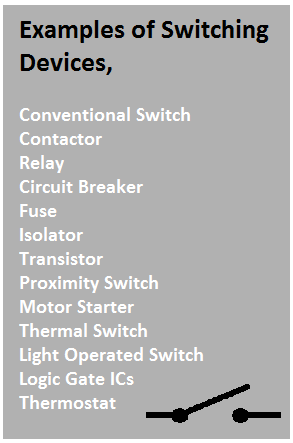Examples of Switching Devices and Their Function
Here, is the list of common Examples of switching devices,
- Conventional Switch
- Contactor
- Relay
- Circuit Breaker
- Fuse
- Isolator
- Transistor
- Proximity Switch
- Motor Starter
- Thermal Switch
- Light Operated Switch
- Logic Gate ICs
- Thermostat
Switching devices are those that can break or make the path of a current-flowing conductor or circuit. So they can stop or start the current flow in a circuit. Basically, they are built with a single or multiple sets of movable contacts. When contacts are connected or touched with each other the switch will be in closed condition but when those contacts are separated from each other the switch will be in open condition. Most of the common types of switches are electromechanical devices which means they control electricity by mechanical movement. From the point of view of control, there are two main types of a switch - manual switch and automatic switch.
Manual switches have some mechanism to turn Off or turn On it manually. Some examples of manual switches are,
- Conventional Switch on the switchboard
- Push Button Switch
- Transformer Isolator Switch
- Remote On/Off switch
The automatic switch has a mechanism that can automatically break or make the circuit with the help of some sensing element, timing control circuit, etc. Some examples of Automatic control switches are,
- Thermal Switch
- Thermostat
- Light Operated Switch
- Proximity Switch
Now. let's discuss about some switching devices listed above. The first one is a conventional switch. Piano-type switches and push-button switches all come in this list and they are manually controlled. To turn on or turn off those switches we have to press them manually.
The second one is a Contactor. A contactor can be called as an electrically controlled switch. It has an electromagnetic coil and sets of contact mechanisms. So when we apply a power supply to the contactor coil the contact mechanism is attracted by the coil and they make a closed contact and current can flow from the input side to the output side. There are different types of contactors such as single-pole, double-pole, or three-pole. Most of the contactor has not only normally open(NO) contacts but they have normally closed(NC) contacts also. So while applying supply to the coil the NC contacts become NO. Generally, NO contacts are used for high-power switching.
A relay is a type of electrically controlled switching device that not only breaks or makes the contact but it diverts the current flow from one conductor to another contactor. Here also we need to apply a power supply to the relay coil for its operation. In Relay, you can see three terminals are there - Common, NO, and NC. In normal conditions, the 'Common' terminal is connected to the 'NC' terminal. But when it is operated the 'Common' terminal will be disconnected from the 'NC' terminal and it will be connected to the 'NO' terminal. So the 'NO' terminal will become 'NC' and the 'NC' terminal will become 'NO'.
Isolators, motor starters, and circuit breakers are also examples of switch devices. Some of them can be operated manually and some of them can be operated automatically.
Read Also:

